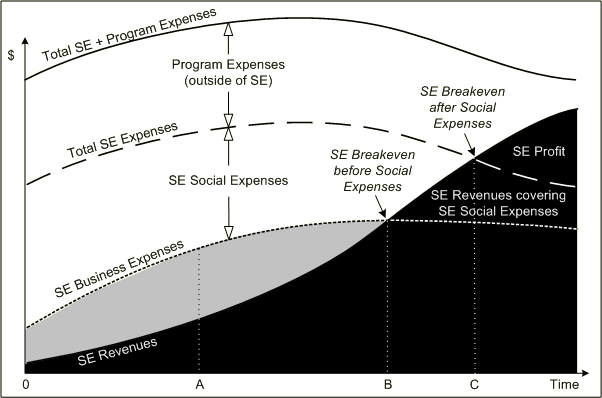Social enterprise is a means to achieve sustainability through earned income; however, it is important to note that financial objectives differ among organizations. Unlike the microfinance field, the financial objective of a social enterprise is not by default viability (generating sufficient income to cover all costs).
Social enterprises don't need to be profitable to be worthwhile. They can improve efficiency and effectiveness of the organization by:
- reducing the need for donated funds;
- providing a more reliable, diversified funding base; or
- enhancing the quality of programs by increasing market discipline. 1
Nonprofit organizations have varying financial motives for incorporating social enterprises into their organizations, ranging from income diversification to full financial self-sufficiency:
- Income Diversification -- For many nonprofit organizations, social enterprise serves as a strategy to diversify their funding base, decrease reliance on donors, and recover or subsidize program costs. In these cases, the social enterprise offers a means to reduce program deficits and employ resources more efficiently. Organizations seeking means to diversify income may set modest financial objectives. For example, the costs of a program previously 100% grant-funded now covered 40% by earned income is success for many organizations.
- Financial Self-Sufficiency -- Financial self-sufficiency is achieved by increasing nonprofit organizations' ability to generate sufficient income to cover all or a substantial portion of their costs or fund several social programs without continued reliance on donor funding. Organizations seeking to maximize profit will opt for external subsidiaries expressly for the purpose of funneling money back to the parent organization. Experienced nonprofits may use complex structures and have multiple mixed enterprises and income streams.
- Cost Savings and Resource Maximization -- This financial objective is usually combined with financial self-sufficiency or income diversification and is concerned with optimizing resources and leveraging assets for economic, social, and community development.
- Cost savings--is achieved by sharing back office functions, optimizing systems, and streamlining efficiencies to increase business performance and margins.
- Resource maximization--is achieved through leveraging the nonprofit's financial assets, tangible assets (space, equipment, plant, building, etc.), and intangible assets (proprietary content, methodology, relationships, goodwill, name recognition, skills, and expertise).
- 1Dees, Gregory, Enterprising Nonprofits, Harvard Business Review, January-February 1998.

